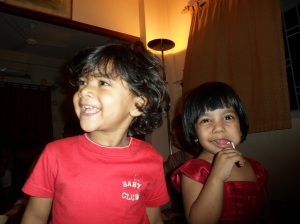Our third farmer meeting was deep in the heartlands of Orissa / Odisha. By the time the road is in the buffer zone it becomes narrow, the tarmac thins and at some point you suddenly realise you are rolling over red earth. And the sensation is one of utter relief, like slipping out of a formal suit at the end of a long sticky meeting, the tarmac falls away and with it the tiresome constraints of town planning. The road winds its own knowledgeable way across open grassland studded with trees, deftly avoiding dry creeks that will fill with water when it rains, doing its best not to collapse into neighbouring ditches, until it slips into the trees and the forest grows up around you. You rarely see other vehicles, we passed our chairs and tables arriving on the back of a bike. We had picked our cook up on the way, the food was in our vehicles, kitchen help arrived, huge cooking pots in hand and a makeshift kitchen was set up. Some 50 metres from the kitchen, chairs and tables were set up in a small clearing (we always get chairs though we hardly sit on them) and a huge tarp was laid on the floor, et voila! Fully catered workshop space!
The understory is filled with saplings, it’s not impenetrable exactly but it would be difficult to walk through, you would be scratched to pieces and in places you might need a blade to cut yourself some space, if you wanted to walk through that is, which is rather unlikely. The dappled light, the slender saplings among larger trees, the falling leaves and, in the summer, the shimmering heat combine to make it hard to focus and the jungle animals pad and slither through, rarely seen but always seeing you. Life is stratified, no niche wasted, from the top of the trees where yellow breasted green pigeons, tree ferns and orchids perch to the forest floor where the jungle fowl cocks bustle their ladies away from the road, the forest is a busy place.
Actually the day was relatively cool, at this end of winter it is only about 28 degrees. The smell of the forest is incredible but almost impossible to describe. I have been a few times and all I can say is that the smell of the forest wraps itself around me like a beautiful embroidered cloak, light and fragrant, infused with earth.
The farmers arrived in small groups, they were organised into groups of 6 or so people and in those groups a structured discussion was initiated. The questions were centred around crop production, pollinator decline, ideas for restoring declining populations. It was clear that there had been dramatic falls in some pollinator species – 95% of blue banded bees for example – 95%! But on the other hand some government initiatives giving training in husbandry were paying off. This area is what we are classifying as extensive farming and it’s the first place that we found crop yields going up – in all other areas crop yields had peaked and were falling. These small groups worked much better than individual questionnaires, the conversation flows freely and there is good discussion with a consensual answer. We turn all the answers into a set of statements which we then run by a subset of people from all the groups and see what they agree with and what they weed out. However, in this case its wasn’t possible to have subset, people would have felt awful being left out and there was no time to break into multiple groups so we tested the statements on the whole group and they came to a consensus on all of it.
I say‘we’, the whole thing was conducted in Oriya – two languages away from me!
We finished with lunch, all of a sudden I was starving! Huge buckets of rice, dal, vegetables and pickle arrived. Sitting in a forest, eating pickle with my fingers, so very far away from London.




 There are lots of grand villas scattered around Kolkata
There are lots of grand villas scattered around Kolkata
 This park is a five minute walk from the guesthouse. It has a network of ponds and a swimming lake.
This park is a five minute walk from the guesthouse. It has a network of ponds and a swimming lake.




















